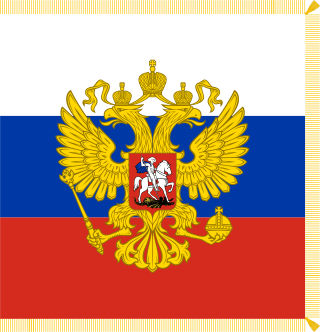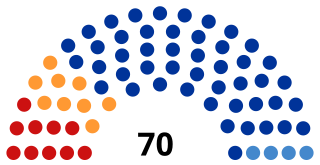
The last Soviet Union (USSR)-era flag was adopted by the Russian SFSR in 1954 and used until 1991. The flag of the Russian SFSR was a defacement of the flag of the Soviet Union. The constitution stipulated:
The state flag of the Russian Soviet Federative Socialist Republic (SFSR) presents itself as a red, rectangular sheet with a light-blue stripe at the pole extending all the width [read height] which constitutes one eighth length of the flag.

A federation is a political entity characterized by a union of partially self-governing provinces, states, or other regions under a federal government (federalism). In a federation, the self-governing status of the component states, as well as the division of power between them and the central government, is constitutionally entrenched and may not be altered by a unilateral decision, neither by the component states nor the federal political body.

The president of the Russian Federation is the executive head of state of Russia. The president is the chair of the Federal State Council and the supreme commander-in-chief of the Russian Armed Forces. It is the highest office in Russia.

The Transcaucasian Socialist Federative Soviet Republic, also known as the Transcaucasian Soviet Federative Socialist Republic, or simply Transcaucasia, was a republic of the Soviet Union that existed from 1922 to 1936.

During its existence, the Soviet Union had three different constitutions enforced individually at different times between 31 January 1924 to 26 December 1991.

The Constitution of the Russian Federation was adopted by national referendum on 12 December 1993. Russia's constitution came into force on 25 December 1993, at the moment of its official publication, and abolished the Soviet system of government. The current Constitution is the second most long-lived in the history of Russia, behind the Constitution of 1936.

The Russian Republic, referred to as the Russian Democratic Federative Republic in the 1918 Constitution, was a short-lived state which controlled, de jure, the territory of the former Russian Empire after its proclamation by the Russian Provisional Government on 1 September 1917 in a decree signed by Alexander Kerensky as Minister-Chairman and Alexander Zarudny as Minister of Justice.

The federal subjects of Russia, also referred to as the subjects of the Russian Federation or simply as the subjects of the federation, are the constituent entities of Russia, its top-level political divisions according to the Constitution of Russia. Kaliningrad Oblast is the only federal subject geographically separated from the rest of the Russian Federation by other countries.

The Parliament of Pakistan is the supreme legislative body of the Islamic Republic of Pakistan. It is a bicameral federal legislature, composed of the President of Pakistan and two houses: the Senate and the National Assembly. The president, as head of the legislature, has the power to summon or prorogue either house of the Parliament. The president can dissolve the National Assembly, only on the Prime Minister's advice.

The Federation Council, or Senate, is the upper house of the Federal Assembly of Russia, according to the 1993 Constitution of the Russian Federation.
Abkhazia is a region in the Caucasus that is under the effective control of the partially recognised self-declared Republic of Abkhazia. The de jure majority internationally recognized Autonomous Republic of Abkhazia claims to be its legitimate government.

The State Assembly of the Republic of Sakha (Yakutia) is the regional parliament of Sakha, a federal subject of Russia. A total of 70 deputies are elected for five-year terms.

The Constituent Assembly of Georgia was a national legislature of the Democratic Republic of Georgia which was elected in February 1919 to ratify the Act of Independence of Georgia and enact the Constitution of 1921. The assembly remained active until the Soviet Russian military intervention brought Georgia’s three-year independence to an end in March 1921.

The Declaration of State Sovereignty of the Russian SFSR was a political act of the Russian Soviet Federative Socialist Republic, then part of the Soviet Union, which marked the beginning of constitutional reform in Russia. The Declaration was adopted by the First Congress of People's Deputies of the Russian SFSR on 12 June 1990. It proclaimed the sovereignty of the Russian SFSR and the intention to establish a democratic constitutional state within a liberalized Soviet Union. The declaration also states the following:

The Russian Soviet Federative Socialist Republic, previously known as the Russian Soviet Republic and the Russian Socialist Federative Soviet Republic, as well as being unofficially referred to as Soviet Russia, the Russian Federation, or simply Russia, was an independent federal socialist state from 1917 to 1922, and afterwards the largest and most populous constituent republic of the Soviet Union (USSR) from 1922 to 1991, until becoming a sovereign part of the Soviet Union with priority of Russian laws over Union-level legislation in 1990 and 1991, the last two years of the existence of the USSR. The Russian SFSR was composed of sixteen smaller constituent units of autonomous republics, five autonomous oblasts, ten autonomous okrugs, six krais and forty oblasts. Russians formed the largest ethnic group. The capital of the Russian SFSR and the USSR as a whole was Moscow and the other major urban centers included Leningrad, Stalingrad, Novosibirsk, Sverdlovsk, Gorky and Kuybyshev. It was the first socialist state in the world.

The All-Russian Congress of Soviets evolved from 1917 to become the supreme governing body of the Russian Soviet Federative Socialist Republic from 1918 until 1936, effectively. The 1918 Constitution of the Russian SFSR mandated that Congress shall convene at least twice a year, with the duties of defining the principles of the Soviet Constitution and ratifying peace treaties. The October Revolution ousted the provisional government of 1917, making the Congress of Soviets the sole, and supreme governing body. This Congress was not the same as the Congress of Soviets of the Soviet Union which governed the whole Soviet Union after its creation in 1922.

National Youth and Children's Palace, sometimes referred as Pioneer Palace, National Palace or by its original name – Viceroy's Palace, is a historical building located on Rustaveli Avenue in Tbilisi, Georgia.

Shenzhen MSU-BIT University, was established in 2016 as a non-profit higher education institution with an independent status of legal entity. Located in Longgang District, Shenzhen, Guangdong, it was cofounded by Lomonosov Moscow State University, Beijing Institute of Technology, and Shenzhen Municipal People's Government. The permanent campus has received 2.04 billion yuan (US$318 million) in investment from the Shenzhen Municipal Government. Specially for the possibility of opening the university, changes were made to the Russian Federal Law "About Moscow State University Lomonosov and St. Petersburg State University".

Bashkiria, also called Bashkortostan, Bashkurdistan, Lesser Bashkiria, or Autonomous Bashkiria, was a short-lived autonomous state which existed from 1917 to 1919, during the Russian Civil War. Aligned with the Russian State, Bashkiria was attacked and later annexed by the Russian Soviet Federative Socialist Republic, leading to its 1919 collapse and succession by the Bashkir Autonomous Soviet Socialist Republic.


















